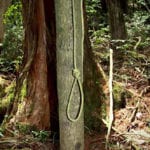 Crime
Crime  Crime
Crime  Technology
Technology 10 Hilariously Over-Engineered Solutions to Simple Problems
 Miscellaneous
Miscellaneous 10 Ironic News Stories Straight out of an Alanis Morissette Song
 Politics
Politics 10 Lesser-Known Far-Right Groups of the 21st Century
 History
History Ten Revealing Facts about Daily Domestic Life in the Old West
 Weird Stuff
Weird Stuff 10 Everyday Products Surprisingly Made by Inmates
 Movies and TV
Movies and TV 10 Actors Dragged out of Retirement for One Key Role
 Creepy
Creepy 10 Lesser-Known Shapeshifter Legends from Around the World
 Animals
Animals 10 Amazing Animal Tales from the Ancient World
 Gaming
Gaming 10 Game Characters Everyone Hated Playing
 Crime
Crime 10 Terrifying Serial Killers from Centuries Ago
 Technology
Technology 10 Hilariously Over-Engineered Solutions to Simple Problems
 Miscellaneous
Miscellaneous 10 Ironic News Stories Straight out of an Alanis Morissette Song
Who's Behind Listverse?

Jamie Frater
Head Editor
Jamie founded Listverse due to an insatiable desire to share fascinating, obscure, and bizarre facts. He has been a guest speaker on numerous national radio and television stations and is a five time published author.
More About Us Politics
Politics 10 Lesser-Known Far-Right Groups of the 21st Century
 History
History Ten Revealing Facts about Daily Domestic Life in the Old West
 Weird Stuff
Weird Stuff 10 Everyday Products Surprisingly Made by Inmates
 Movies and TV
Movies and TV 10 Actors Dragged out of Retirement for One Key Role
 Creepy
Creepy 10 Lesser-Known Shapeshifter Legends from Around the World
 Animals
Animals 10 Amazing Animal Tales from the Ancient World
 Gaming
Gaming 10 Game Characters Everyone Hated Playing
The Ten Most Followed Real-Life Criminal Trials in TV History
When Johnny Depp and Amber Heard faced off in court in 2022, it seemed like the world was watching. Live video feeds captured every second. Blogs and YouTube channels dissected each day’s proceedings. Viewers watched thousands of hours online. No one wanted to miss a salacious moment. However, trial journalism has a winding history that began ages before Johnny and Amber. In fact, today’s frenzied court coverage all links back to one case: the 1935 trial of Bruno Richard Hauptmann, the man convicted of kidnapping Charles Lindbergh’s baby.
Media coverage was overwhelming in that trial. Journalists from hundreds of news outlets descended on the courthouse. Photographers climbed over tables, and flashbulbs exploded in witnesses’ faces during testimony. The coverage was so intense that the American Bar Association banned cameras from courtrooms. For four decades, the ban mostly stayed in place. But as time passed, judges slowly began to re-grant access. In 1991, federal courts started allowing cameras in civil trials. Months later, Court TV was formed and immediately began wall-to-wall coverage.
Today, almost every state allows cameras in court with varying rules. Ever since, television viewers have flocked to watch real-life courtroom drama. And here are ten of the most-followed TV trials ever.
Related: Top 10 People Found Guilty At Trial Due To Surprise Evidence
10 Ted Bundy
Serial killer Ted Bundy’s 1979 trial was the first one televised nationwide. A month before he took the stand to face murder accusations in Tallahassee, the Florida Supreme Court decided to allow journalists to film trials in the state. So when Bundy went on the stand, the courtroom was filled with more than 250 reporters from across the world.
The murderer was handsome and charismatic, and news agencies couldn’t get enough.
Bundy’s outward charm may have hidden his horrific and murderous desires, but it also made for great TV. Shocked at the scene inside his courtroom, Judge Edward Cowart likened the cameras to “a space center.” Bundy was eventually found guilty of the two murders with which he was charged and later sentenced to death. Along the way, millions of people tuned in to watch the case. Today, experts point to Bundy’s public spectacle as the birth of salacious true crime news coverage.[1]
9 The Menendez Brothers
Lyle and Erik Menendez were attractive, athletic, and rich. So when they were accused of murdering their parents in 1989, the brothers quickly rose to infamy. Detectives said the pair shot their wealthy parents and then spent their money before being arrested. The boys countered with claims that they had been victims of sexual abuse. The story resembled a soap opera, and television producers pounced.
When the case first went to trial in 1993, Court TV cameras showed it all. Jurors were deadlocked during deliberations, and the judge declared a mistrial. Both sides prepared for a second showdown. Court TV was happy to air that one, too, after the network gained three million subscribers during the first trial. The public was so invested in the spectacle that the LA District Attorney’s Office was getting dozens of calls every day from viewers with ideas on how to prosecute the brothers.
By the time Lyle and Erik were convicted at the second trial in 1996, millions of people followed along. Court TV’s ratings win encouraged other networks to air trial content. Fortunately for producers, the perfect case was right there for the airing…[2]
8 O.J. Simpson
O.J. Simpson had it all: The former college football sensation and pro football star was a successful actor with a big bank account and a beautiful family. So when he was accused of murdering his ex-wife in 1994, his fall from grace shocked the world. His bizarre slow-speed police pursuit was broadcast live on TV and set the tone for the public’s fascination. When he went on trial in 1995, attention quickly trumped the Menendez case, and Simpson became the biggest media spectacle ever.
When the jury declared him not guilty of murder, more than 150 million Americans—almost 60% of the country—watched on TV. Telecom companies nationwide recorded a 50% drop in phone use during the verdict. Water companies saw usage decline as viewers delayed bathroom breaks to watch. After the trial ended, CNN and Court TV saw viewer declines for non-O.J. content.
Concern over the fall in ratings pushed news outlets to cover more trials. O.J.’s public interest never waned. Two decades later, nearly 14 million people watched the ex-football star’s parole hearing following a nine-year prison sentence for armed robbery.[3]
7 Adolf Eichmann
While Ted Bundy’s 1979 murder rap kicked off the true crime craze in America, it wasn’t the world’s first televised trial. That dark distinction belongs to war criminal Adolf Eichmann. In his military life, Eichmann was responsible for transporting millions of Jews to Holocaust death camps during World War II. After the war, he escaped to Argentina and went into hiding. Fleeing kept him from consequences at the Nuremberg Trials after the war. Eichmann’s luck didn’t last forever, though.
In 1960, Israeli special agents tracked him down in South America. A year later, he went on trial for war crimes related to the genocide. Israeli courts allowed the entire trial to be televised, becoming the world’s first courtroom TV event. Millions of people tuned in to watch the shocking testimony of Holocaust survivors. The broadcast proved extremely significant: it was the first time much of the world learned about what happened in the concentration camps. Eichmann was found guilty of war crimes and executed by hanging in 1962.[4]
6 William Kennedy Smith
William Kennedy Smith was a medical student in 1991 when he visited Florida with his uncle. At a bar one night, he met a woman named Patricia Bowman. The two went back to William’s place. Once there, something went wrong, and Bowman accused him of assault and rape. Smith wasn’t just any medical student, though. He was John F. Kennedy’s nephew. And the uncle with whom he’d been traveling was Massachusetts Senator Ted Kennedy. So when Smith went on trial later that year, Court TV was ready.
The network covered every moment of the trial and saw its ratings surge. Every night, non-24-hour entertainment news shows like Inside Edition aired key moments from the testimony. Media interest was so intense that tabloid shows took unethical steps for access. One prosecution witness admitted she was paid $40,000 to take part in two TV interviews on A Current Affair.
As for Smith, he was acquitted of the charges against him. Journalists offered the acquittal as a victory for having television cameras in court since the coverage allowed millions of Americans to see the justice system at work.[5]
5 Jeffrey Dahmer
Like Ted Bundy more than a decade earlier, serial killer Jeffrey Dahmer drew a macabre following once his crimes came to light. When Dahmer was charged with 15 murders and ordered to stand trial in 1992, 24-hour news channels were relatively new. When looking to fill time around the clock, networks jumped at the opportunity to cover Dahmer’s shocking exploits. In Milwaukee, where many of his murders took place, interest was particularly high.
But Dahmer’s violent acts proved a bit too disturbing even for tabloid TV coverage. Court TV aired the trial on a 20-second delay as producers rushed to edit out grisly testimony about the victims’ remains. Other networks weren’t able to sanitize their footage as quickly. The disgusting content didn’t damage viewership, though. When the jury’s guilty verdict came back, more than 60 news organizations aired it around the world. Dahmer was sentenced to 957 years in prison for the murders. Two years later, he was killed by another inmate.[6]
4 Rodney King
The 1992 trial of four Los Angeles police officers over the brutal beating of Rodney King didn’t garner as much of a worldwide following as some on this list. But no trial in American history has had as violent an aftermath as this one. It started in 1991 when King was attacked by several LAPD officers after a pursuit. A witness secretly recorded a video of the beating. When it aired on news networks, people nationwide were outraged over King’s treatment at the hands of the cops.
Four officers were ultimately charged with assault and excessive use of force. Tensions were so high that their 1992 trial had to be moved to nearby Ventura County. Courtroom coverage proved lucrative for networks, with viewers in southern California especially interested. That was nothing compared to what happened after the verdict, though.
When the officers were acquitted of the assault charges, frustrated Angelenos erupted. Five days of rioting throughout the city resulted in more than $1 billion in property damage, 63 deaths, and more than 2,300 injuries. With the horrified nation looking on, President George H.W. Bush had to send in the National Guard to restore order.[7]
3 Casey Anthony
It’s impossible to hear Casey Anthony’s name without thinking of Nancy Grace. A former prosecutor, Grace was a popular TV commentator on HLN when Casey’s two-year-old daughter Caylee was found dead in Florida in December 2008. On her primetime show, Grace seized on the case. She famously called Casey “Tot Mom” on air and obsessively analyzed evidence. The TV host slammed Casey for allegedly misleading police about Caylee’s last-known whereabouts. After pictures of the mom partying after her daughter’s death were uncovered, Grace erupted.
As Casey’s trial began in 2011, HLN went into overdrive. Grace’s fanatical coverage paid off for the network. HLN viewership nearly doubled during the six-week trial. On the day of the verdict, 5.2 million people tuned in live—the channel’s highest ratings ever. When the jury unexpectedly announced Casey’s acquittal, audiences watched as Grace memorably fumed, “the devil is dancing tonight,” and “Caylee’s death has gone unavenged!”[8]
8 Jodi Arias
Police suspected Jodi Arias of murder after her ex-boyfriend Travis Alexander was brutally stabbed to death in 2008. It took more than five years for the legal process to run its course, though. During that time, sordid details about the former couple’s life made it one of the first true crime stories to go viral online. The case was complicated, and Arias’s first two trials ended in hung juries. She eventually admitted to killing Alexander but claimed it had been in self-defense.
In court, prosecutors presented evidence that Arias took pictures of her ex as he was bleeding to death. Just as she did with Casey Anthony, Nancy Grace hammered home shocking details about Arias’s love life and mindset for the entire 19-week trial. HLN’s viewership skyrocketed on the day Arias was sentenced to life in prison following a guilty verdict in May 2013. Her lawyers were shocked by the “circus-like atmosphere” of the television coverage at the trial. They filed an appeal, arguing the court failed to protect their client from the relentless media coverage. Thus far, her conviction has been upheld.[9]
1 Lindsay Lohan
Former child star Lindsay Lohan’s 2010 trial didn’t cover the same level of crime as the rest on this list. In her case, the Parent Trap star was called in front of a judge after two drunk driving arrests and multiple probation violations. But the Hollywood star was an emotional wreck in court. Viewers watched as Lohan sobbed uncontrollably while addressing the judge. The media frenzy increased after cameras picked up a profane message subtly painted on her fingernails.
In the end, Lohan’s sentence was relatively minor. The judge ordered her to spend 90 days in jail and another 90 days in rehab. Her story drew a new kind of attention, though: TMZ streamed the July 2010 verdict live online and drew nearly 2.5 million website hits. With that threshold crossed, online virality quickly began to usurp must-see TV. But no matter the broadcast technology, the public’s interest in scandal has never slowed. From Hauptmann to Heard, viewers are as interested in high-pressure trials today as they’ve ever been.[10]








